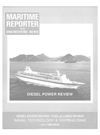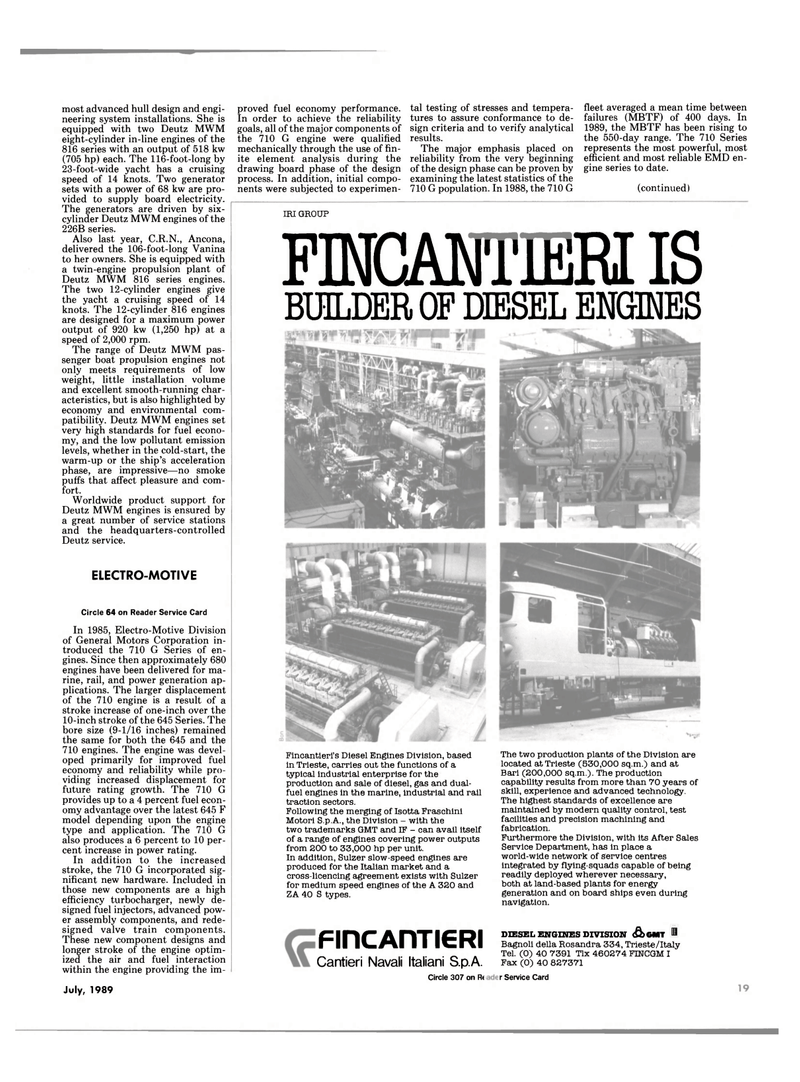
Page 17: of Maritime Reporter Magazine (July 1989)
Read this page in Pdf, Flash or Html5 edition of July 1989 Maritime Reporter Magazine
most advanced hull design and engi- neering system installations. She is equipped with two Deutz MWM eight-cylinder in-line engines of the 816 series with an output of 518 kw (705 hp) each. The 116-foot-long by 23-foot-wide yacht has a cruising speed of 14 knots. Two generator sets with a power of 68 kw are pro- vided to supply board electricity.
The generators are driven by six- cylinder Deutz MWM engines of the 226B series.
Also last year, C.R.N., Ancona, delivered the 106-foot-long Vanina to her owners. She is equipped with a twin-engine propulsion plant of
Deutz MWM 816 series engines.
The two 12-cylinder engines give the yacht a cruising speed of 14 knots. The 12-cylinder 816 engines are designed for a maximum power output of 920 kw (1,250 hp) at a speed of 2,000 rpm.
The range of Deutz MWM pas- senger boat propulsion engines not only meets requirements of low weight, little installation volume and excellent smooth-running char- acteristics, but is also highlighted by economy and environmental com- patibility. Deutz MWM engines set very high standards for fuel econo- my, and the low pollutant emission levels, whether in the cold-start, the warm-up or the ship's acceleration phase, are impressive—no smoke puffs that affect pleasure and com- fort.
Worldwide product support for
Deutz MWM engines is ensured by a great number of service stations and the headquarters-controlled
Deutz service.
ELECTRO-MOTIVE
Circle 64 on Reader Service Card
In 1985, Electro-Motive Division of General Motors Corporation in- troduced the 710 G Series of en- gines. Since then approximately 680 engines have been delivered for ma- rine, rail, and power generation ap- plications. The larger displacement of the 710 engine is a result of a stroke increase of one-inch over the 10-inch stroke of the 645 Series. The bore size (9-1/16 inches) remained the same for both the 645 and the 710 engines. The engine was devel- oped primarily for improved fuel economy and reliability while pro- viding increased displacement for future rating growth. The 710 G provides up to a 4 percent fuel econ- omy advantage over the latest 645 F model depending upon the engine type and application. The 710 G also produces a 6 percent to 10 per- cent increase in power rating.
In addition to the increased stroke, the 710 G incorporated sig- nificant new hardware. Included in those new components are a high efficiency turbocharger, newly de- signed fuel injectors, advanced pow- er assembly components, and rede- signed valve train components.
These new component designs and longer stroke of the engine optim- ized the air and fuel interaction within the engine providing the im-
July, 1989 proved fuel economy performance.
In order to achieve the reliability goals, all of the major components of the 710 G engine were qualified mechanically through the use of fin- ite element analysis during the drawing board phase of the design process. In addition, initial compo- nents were subjected to experimen- tal testing of stresses and tempera- tures to assure conformance to de- sign criteria and to verify analytical results.
The major emphasis placed on reliability from the very beginning of the design phase can be proven by examining the latest statistics of the 710 G population. In 1988, the 710 G fleet averaged a mean time between failures (MBTF) of 400 days. In 1989, the MBTF has been rising to the 550-day range. The 710 Series represents the most powerful, most efficient and most reliable EMD en- gine series to date. (continued)
IRI GROUP
Fincantieri's Diesel Engines Division, based in Trieste, carries out the functions of a typical Industrial enterprise for the production and sale of diesel, gas and dual- fuel engines In the marine, industrial and rail traction sectors.
Following the merging of Isotta Fraschini
Motori S.p.A., the Division - with the two trademarks GMT and IF - can avail itself of a range of engines covering power outputs from 200 to 33,000 hp per unit.
In addition, Sulzer slow-speed engines aire produced for the Italian market and a cross-licencing agreement exists with Sulzer for medium speed engines of the A 320 and
ZA 40 S types.
FinCAnTIGRI
Cantieri Navali Italiani S.p.A.
Circle 307 on R<
The two production plants of the Division are located at Trieste (530,000 sq.m.) and at
Bari (200,000 sq.m.). The production capability results from more than 70 years of skill, experience and advanced technology.
The highest standards of excellence are maintained by modern quality control, test facilities and precision machining and fabrication.
Furthermore the Division, with its After Sales
Service Department, has in place a world-wide network of Service centres integrated by flying-squads capable of being readily deployed wherever necessary, both at land-based plants for energy generation and on board ships even during navigation.
DIESEL ENGINES DIVISION <&GMT ^
Bagnoli della Rosandra 334, Trieste/Italy
Tel. (0) 40 7391 Tlx 460274 FINCGM I
Fax (0) 40 827371 r Service Card
FmCAMTERI IS
BUILDER OF DIESEL ENGINES

 16
16

 18
18
